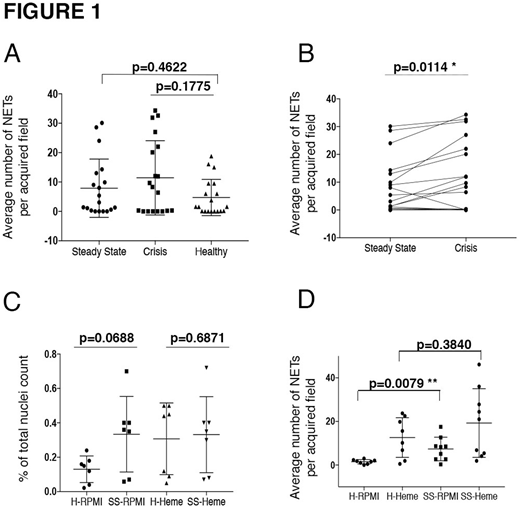Abstract
Polymerisation of deoxygenated-HbS in sickle cell disease (SCD) leads to alteration of the shape and function of the red blood cells (RBC), resulting in hemolytic anemia and recurrent episodes of micro-vascular occlusion, triggering a cascade of downstream events and inflammation that underlies the progressive multi-systemic organ damage. Neutrophils have a critical role in promoting sickle pathophysiology; patients with higher leukocyte count, particularly neutrophils, tend to have a higher risk for more severe manifestations as well as earlier mortality. SCD neutrophils display a specific overreactive phenotype, including increased adhesive properties and production of reactive oxygen species. Activated neutrophils can also produce extracellular traps (NETs) in response to pathogens or other inflammatory stimuli. Studies have shown that prolonged exposure of healthy neutrophils to SCD plasma leads to formation of mature string-like NETs. These strings of decondensed chromatin covered with elastase (NE) or myeloperoxidase (MPO) might contribute to SCD pathophysiology. Here, we investigated if SCD neutrophils had enhanced intrinsic potential for NETs formation (i.e. could form NETs in the absence of a stimulus).
We evaluated NETosis both indirectly, in which neutrophils isolated from healthy subjects were incubated with plasma from HbSS patients and directly, in which neutrophils isolated from HbSS patients were compared with those isolated from healthy donors. 17 HbSS patients in steady-state (all on hydroxyurea) and 11 race and sex matched healthy donors were included in the direct assays; the NETosis-related events were observed over a period of 7 minutes to 4 hours. For the indirect assay, we used plasma from 19 HbSS patients (14 on hydroxyurea, 5 off hydroxyurea and/or transfused), all of whom provided samples in steady-state and acute pain crisis (paired samples); the healthy neutrophils were treated with SCD plasma for up to 7 hours. A pain crisis was defined as an episode of acute pain that has no evident cause other than SCD, resulting in hospitalization and treatment with parenteral opioids. Steady state was defined as the period from at any time 8 weeks prior to or after a crisis. Patients were excluded when they were <18 or >80 years of age, pregnant or had a history of blood transfusion in the previous 8 weeks. The IRB approved the studies under NIH protocol numbers NCT00081523 (SCD subjects) and 03-H-0015 (healthy controls and SCD subjects). The NETosis features (histone citrullination H4cit3, nuclear decondensation, DNA-NE-MPO strings) were assessed by imaging flow cytometry and fluorescence microscopy.
In the indirect assays, healthy neutrophils made more string NETs when treated with the SCD plasma (from both steady state and crisis) compared to plasma from healthy donors (Figure 1A), and NETs response was further increased with plasma from acute compared to their paired steady state sample (N=19, p=0.0114) (Figure 1B). Plasma from patients on or off hydroxyurea induced comparable NETosis responses. This confirmed a higher ability for the crisis milieu to modulate NETosis.
Directly, neutrophils isolated from SCD patients as compared to those from healthy controls, showed increased number of decondensed H4cit3 positive nuclei, after only 7 min of incubation in RPMI (N=7, p=0.0688). By comparison the response to high concentration (20 uM) of Hemin - a regular product of hemolysis, was similar in the SCD and the healthy neutrophils (p=0.6871) (Figure 1C). This data suggested that the SCD environment might activate neutrophils to produce NETs in the absence of a specific stimulus. Fluorescence microscopy confirmed that neutrophils isolated from the patients did produce significantly more DNA-NE strings without any stimulation compared to healthy neutrophils (N=9, p=0.0079). After Hemin treatment, NETs response in SCD neutrophils was also higher than that of the healthy controls, but not statistically significant (Figure 1D).
Our data provide the first direct in vitro evidence that neutrophils in SCD are innately prone to NETosis but whether and how these might contribute to the initiation or progress of SCD vaso-occlusive crises is yet to be determined.
No relevant conflicts of interest to declare.
Author notes
Asterisk with author names denotes non-ASH members.


This feature is available to Subscribers Only
Sign In or Create an Account Close Modal